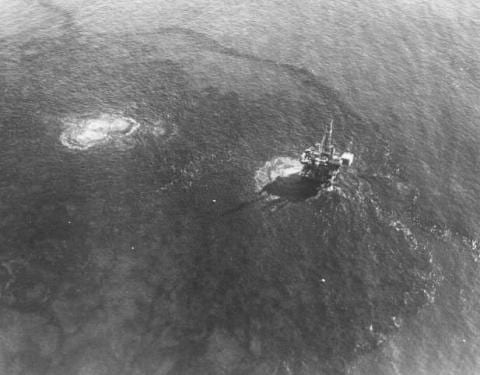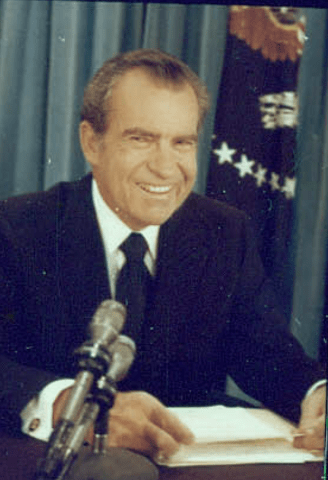Overview
B. Alex Beasley
In October 1973, the Arab state members of the Organization of Petroleum Exporting Countries (OPEC) declared that they would cut oil production, and limit exports to certain countries, to protest the United States’ support for Israel in the Yom Kippur War. American policymakers believed that this decision, which they called an “embargo,” would raise the market price of oil as supplies diminished and would lead to shortages of oil in the United States.
In response, President Richard Nixon instituted a rationing program intended to safeguard American oil supplies and ensure continued low prices. Nixon’s policy helped lead to shortages at gasoline stations. Americans lined up at pumps for limited supplies, and engaged in a national conversation about the threat of “foreign oil” and the nation’s reliance on petroleum. At the same time, the U.S. economy suffered simultaneous recession and inflation (termed stagflation), further weakening American confidence in the nation’s stability and prestige at home and abroad. The 1973-74 “energy crisis” is a key moment in U.S. political, cultural, and economic history, and a central chapter in the history of the global oil economy.
Press coverage of OPEC’s actions and of dwindling U.S. oil reserves prompted widespread political concern about U.S. reliance on imported oil. During the 1960s, the U.S. had strictly limited oil imports to the United States to protect U.S. oil producers. These import restrictions had the unintended effect of depleting domestic reserves even more quickly. At the same time, oil demand rose rapidly after World War II. Twentieth-century U.S. oil production peaked in 1970. In April 1973, the federal government loosened restrictions on oil imports, and they quickly grew from 2.2 million barrels per day in 1967 to 6 million barrels per day. When OPEC slashed its production in November 1973, government officials and the American public panicked about the power of foreign oil producers to impact life at home.
Anxiety about dependence on foreign oil dovetailed with growing environmental concerns about petroleum. In January 1969, a well blew out off the California coast near Santa Barbara, capturing headlines and television coverage. Smog from automobile emissions prompted new clean air regulation. Environmental activists, and some government officials, declared that energy conservation and new energy sources such as solar power could solve the energy crisis, simultaneously mitigating the threat of “foreign oil,” fossil fuels’ environmental consequences, and potential future oil shortages.
President Nixon responded to the energy crisis by instituting a strict rationing program. In hindsight, this rationing program had more drastic effects at home than did OPEC. The image of Americans waiting in long lines at the pump for gasoline symbolized the end of a post-World War II era of economic growth and prosperity and a new, uncertain future. President Carter directly addressed this uncertainty in an address he delivered to the public in 1979, which came to be known as the “crisis of confidence” speech. At the same time, Americans’ understanding of the threat of “foreign oil” dovetailed with existing racist ideas about the Arabs and the Middle East, and U.S. popular culture produced a number of racist depictions of foreign oil producers taking advantage of the American public.
Cite this overview:
Beasley, B. Alex. “Overview: The Oil Shocks of the 1970s.” Energy History Online. Yale University. 2023. https://energyhistory.yale.edu/the-oil-shocks-of-the-1970s/.
Library Items
“Santa Barbara Declaration of Environmental Rights,” 1970
On January 28, 1969, an oil well blew out in the Santa Barbara channel. President Richard Nixon had just been inaugurated one week earlier and the oil spill, widely covered in the media including on television, helped frame a growing political concern about a perceived environmental crisis in the United States and the world. In Santa Barbara itself, environmental activists organized to oppose offshore oil drilling. In the aftermath of the oil spill, they also articulated a broad concern about environmental problems.
Gas Shortages, Oregon 1973-74 (gallery)
The Environmental Protection Agency’s Documerica photography project captured scenes from the energy shocks of 1973–1974, including these photos of gas stations in Oregon.
In what ways might these photographs stand for the broader economic and environmental crises of the 1970s?
Time, Magazine Cover “The Big Car: End of the Affair”
After the 1973 OPEC oil embargo and a sharp rise in the cost of oil and gasoline, American automakers began to produce smaller, more fuel-efficient cars. In this 1973 issue, Time magazine proclaimed the end to “big cars” on American roads. How might this have been seen as a significant shift in American culture?
Political Cartoon: Held Up at the Pump
This political cartoon satirizes the 1973 OPEC decision to reduce oil production to pressure the United States and Western Europe. It portrays an Arab leader holding up political leaders (including Richard Nixon), using a gas pump as a gun. What’s the message of the cartoon?
Richard Nixon, “Address to the Nation About Policies To Deal With the Energy Shortages,” November 7, 1973 (excerpts)
In this 1973 speech, President Richard Nixon outlines his plans to reduce national energy consumption and calls on U.S. citizens to follow his lead in achieving energy independence. What role did Nixon see for coal and nuclear power in providing new sources of energy? How had changes in American energy consumption helped create the energy crisis? What were implications for environmental regulation and domestic energy production?
Jimmy Carter, “Address to the Nation on Energy,” April 18, 1977 (excerpts)
President Carter delivered this speech on the energy crisis in 1977. He proposed a plan to solve the crisis that focused on expanding the government’s responsibility, promoting conservation, and expanding the search for oil to previously untapped areas. What does Carter’s speech tell us about the ways that the energy crises transformed the ways politicians were thinking about the relationship of the state and the environment?
Jimmy Carter, “Crisis of Confidence” Speech, July 15, 1979 (excerpts)
In this speech, Carter recognizes that Americans have lost faith in government, in part because of the energy crisis. How does Carter link the energy crisis to a crisis of the American spirit? What are his proposed solutions? To what extent are his solutions in tension with each other? How does his analysis of the problem seem decades later?
Additional Reading
Borstelmann, Thomas. The 1970s: A New Global History from Civil Rights to Economic Inequality. Princeton, NJ: Princeton University Press, 2012.
Horowitz, Daniel. Jimmy Carter and the Energy Crisis of the 1970s: A Brief History with Documents. New York: Bedford/St. Martin’s, 2004.
Huber, Matthew T. Lifeblood: Oil, Freedom, and the Forces of Capital. Minneapolis: University of Minnesota Press, 2013.
Jacobs, Meg. Panic at the Pump: The Energy Crisis and the Transformation of American Politics in the 1970s. New York: Hill & Wang, 2017.
Mitchell, Timothy. Carbon Democracy: Political Power in the Age of Oil. New York: Verso, 2011.
Sargent, Daniel J. A Superpower Transformed: The Remaking of American Foreign Relations in the 1970s. New York: Oxford University Press, 2015.
Stern, Roger J. “Oil Scarcity Ideology in US Foreign Policy, 1908-97.” Security Studies 25, no. 2 (May 2016): 214-257.
Jadaliyya. “Oil: The Stuff of Mass Delusion.” Accessed March 9, 2016.
Wight, David M. “The Petrodollar Era and Relations between the United States and the Middle East and North Africa, 1969-1980.” PhD Diss. University of California, Irvine, 2014.
Yergin, Daniel. The Prize: The Epic Quest for Oil, Money, and Power. New York: Free Press, 1991.
Zaretsky, Natasha. No Direction Home: The American Family and the Fear of National Decline, 1968-1980. Chapel Hill: University of North Carolina Press, 2007.
Author Bio
B. Alex Beasley is an Assistant Professor in American Studies at the University of Texas at Austin.






